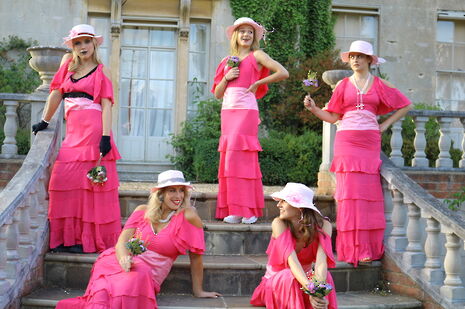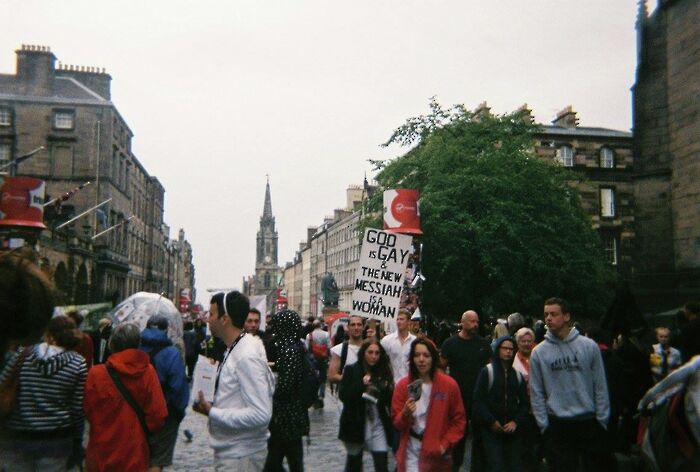Five women wearing the same dress review
This intimate play boasts brilliant performances and monstrous dresses

Alan Ball’s 1993 play is set in Knoxville, Tennessee: the five bridesmaids of Tracey Marlowe retire to a bedroom in order to escape the evidently strained and tedious wedding celebrations taking place downstairs. The comedic and moving elements are perfectly balanced in this performance by Gold Thread Productions, directed by Oxford student Lara Marks, as the women unravel each other’s stories and forge alliances in spite of their differences.
In its small, intimate venue, the theatrical experience becomes greatly immersive by virtue of the audience’s proximity to the actors
The cast boasts an array of formidable talent, with stand-out performances from Lucia Proctor-Bonbright (Mindy) and Abby McCann (Frances) in particular. Proctor-Bonbright is unwaveringly consistent in her portrayal of the bride’s clumsy sister-in-law, who has been repeatedly snubbed by society and her family since coming out as a lesbian. Subtlety of facial expression and an impeccable southern accent ensure that her portrayal appears the most natural: it is no surprise to learn from the programme that she is taking up a place at RADA.
McCann is extremely amusing as the prim young Christian, maintaining a farcical quality whilst also deftly navigating the character’s fluctuation between steadfast devotion and succumbing to temptation. However, all the women in the cast prove themselves to be greatly talented. The characterisation of all five women is generally very convincing, hiccups with the difficult accent aside, and their interaction as a collective is both fluid and immensely enjoyable.
The performance lends itself perfectly to the small and intimate venue to which it has been assigned, as all the action takes place in a bedroom over the course of a wedding reception. The audience are close enough to see the tracks of smudged mascara on Georgeanne’s cheeks, the full effects of Frances’ makeover and the tears that quietly escape from Tricia – details that would undoubtedly be lost in a larger venue. This greatly amplifies the tension, which builds to an almost unbearable climax, as the theatrical experience becomes greatly immersive by virtue of the audience’s proximity to the actors.
The onlookers become similarly bound by the connections that are forged between the female characters and it becomes impossible to wrench one’s attention away
The admission of spectators into this deeply loaded setting, in which the bed looms large as the central focus, is reflective of the openness with which the women begin to discuss their sexual experiences. The onlookers become similarly bound by the connections that are forged between the female characters and it becomes impossible to wrench one’s attention away from the compelling arguments and admissions, apologies and reconciliations: the two hours slide by effortlessly.
The bride and groom remain absent from the scene, as do the majority of the other characters referenced by those on stage. The overtly feminine space, which has been furnished with female-dominated discourse, is penetrated by only one male figure throughout the play. Following such a captivating and wide-ranging interaction between five women, this masculine intrusion feels extremely unwelcome and perhaps even jarring, despite Tripp Davenport’s honourable intentions in regard to Tricia. This sensation is not a reflection on the skills of Hasan Al-Habib (Tripp) as such, but more a testament to the preceding dialogue which has done much to establish a powerful and liberating discursive space inhabited by Frances, Meredith, Tricia, Georgeanne and Mindy. The chemistry between the pair is not entirely believable when contrasted with the strength of the interaction between the women.
The titular dress is every bridesmaid’s nightmare, replicated five-fold: a frilly pink monstrosity, better suited to a confectionery counter than a church
The titular dress itself is a crucial component of the production. The thing is every bridesmaid’s nightmare, replicated five-fold: a frilly pink monstrosity, better suited to a confectionery counter than a church.
Only Frances doesn’t mind looking like a ‘cake’. However, whilst Tracey the absent bride may not have been thoughtful in her choice of bridesmaid outfit, costume designer Marisa Crane certainly has: each ensemble has subtle individual touches which the audience are close enough to note. The hats might uniformly resemble lampshades, but that of Frances is adorned with a pink rosary, whilst Mindy sports a rainbow ribbon on hers. Meredith’s gown is trimmed with black ribbon, an affronting symbol of rebellion which matches her black lipstick, whilst Tricia has a neckline of small gemstones.
These tokens appear to symbolise the facets of femininity which are displayed by the different characters: they constitute pleasing visual cues for observant spectators. The embellishments nicely enhance the overall narrative, which concludes that whilst the women turn out to be united by more than what divides them, they maintain their individual distinctions.
It is also worth noting that the profits of the show are being donated to Clean Break, a charity which works to provide a theatrical platform as a means of self-expression for marginalised women. Altogether, the combined talent of both cast and crew make for a heady combination: Five Women Wearing the Same Dress is absolutely worth the ticket price and more, particularly as it benefits such a topical charitable cause - truly a riveting and immersive performance.
 News / Police to stop searching for stolen Fitzwilliam jade17 April 2024
News / Police to stop searching for stolen Fitzwilliam jade17 April 2024 Interviews / ‘It fills you with a sense of awe’: the year abroad experience17 April 2024
Interviews / ‘It fills you with a sense of awe’: the year abroad experience17 April 2024 News / Night Climbers call for Cambridge to cut ties with Israel in new stunt15 April 2024
News / Night Climbers call for Cambridge to cut ties with Israel in new stunt15 April 2024 Sport / Kabaddi: the ancient sport which has finally arrived in Cambridge17 April 2024
Sport / Kabaddi: the ancient sport which has finally arrived in Cambridge17 April 2024 Features / Cambridge’s first Foundation Year students: where are they now?7 April 2024
Features / Cambridge’s first Foundation Year students: where are they now?7 April 2024






